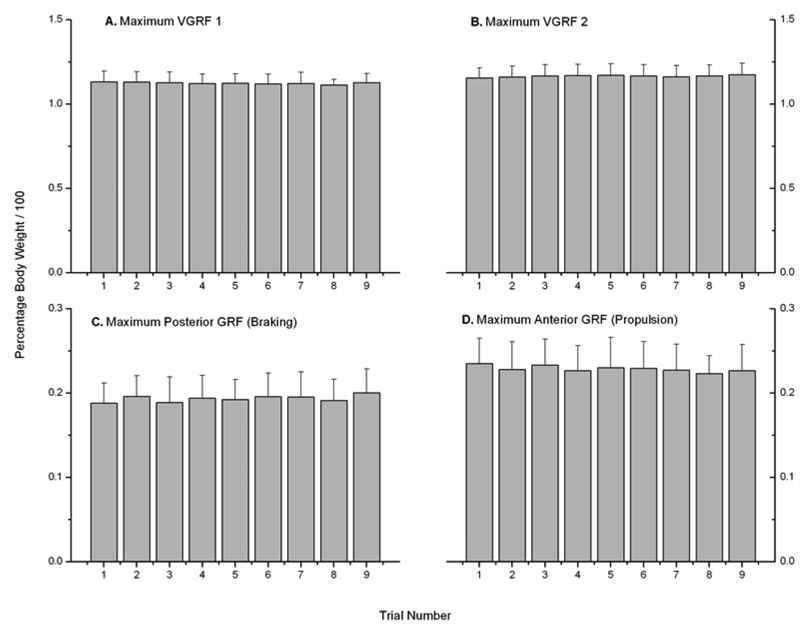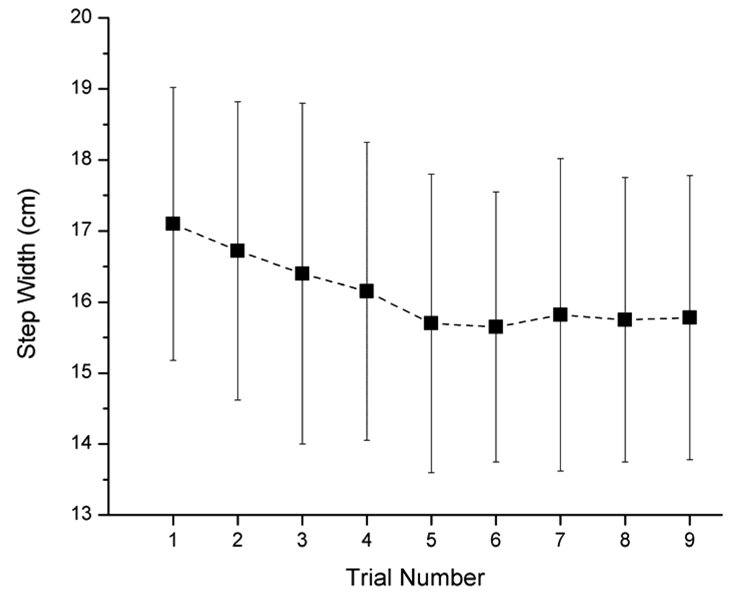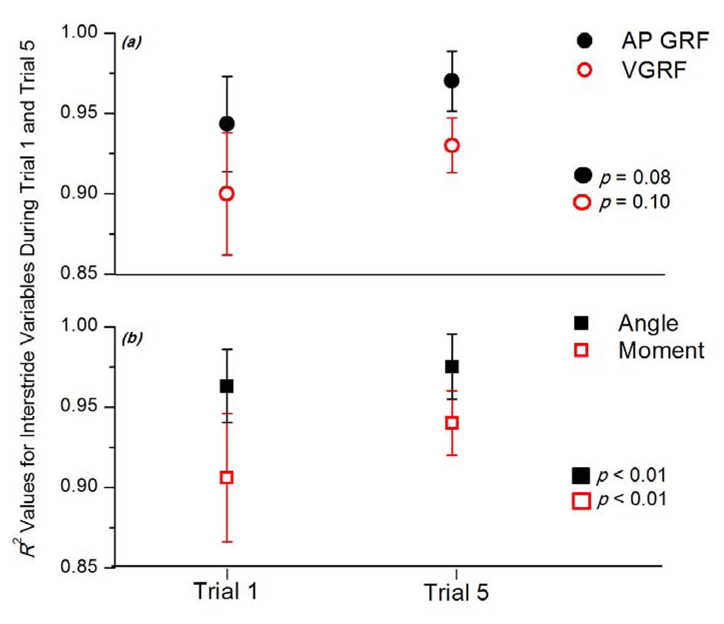Abstract
Background
Subjects unfamiliar to walking on a split-belt treadmill may initially demonstrate an altered gait pattern or increased variability of gait parameters. While previous investigations have examined kinematic variables associated with familiarization time, the objective of this study was to determine the familiarization period required to obtain the most reproducible gait pattern through the assessment of kinetic, kinematic and spatio-temporal parameters during a single session of treadmill walking.
Methods
Eleven healthy subjects participated in a single bout of treadmill walking which lasted nine minutes. Kinematic and kinetic data were collected from the first thirty seconds of each minute, beginning when the treadmill reached full speed. Means and standard deviations for knee flexion at heel strike, ground reaction forces, step width and step length were obtained to examine the changes in each variable over the nine minutes. Mean r2 values were evaluated for changes in variability from one stride to the subsequent stride for sagittal plane hip, knee and ankle joint angles and moments, as well as for vertical and horizontal ground reaction forces.
Findings
Significant reductions in variability were found for vertical and horizontal ground reaction forces, knee flexion at heel strike and step length over 9 minutes. Only step width showed a change in the mean value across trials. There were no increases in r2 values after the 5th minute for any of the gait variables.
Interpretation
The results suggest that in order to collect accurate data for gait analysis, subjects should be familiarized to the split-belt treadmill for at least 5 minutes prior to data collection.
Keywords: Biomechanics, Gait, Gait variability, Kinematics, Gait Analysis
1. Introduction
Split-belt treadmills are becoming more common in gait analysis and interventional research (Hidler and Neckel, 2006; Hidler, 2004; Reisman et al., 2007). While the use of this instrument has been shown to be a valid method of collecting walking data, the familiarization period for the novel task of split-belt treadmill walking has not been evaluated (Tesio and Rota, 2008). This is an important consideration as subjects unfamiliar to treadmill walking may require a period of acclimatization before strides become reproducible (Owings and Grabiner, 2003). Previous work has shown that joint kinematics during treadmill walking are comparable to overground walking, so long as subjects are given sufficient familiarization time (Lemke et al., 1995; Murray et al., 1985; Riley et al., 2007; Tesio and Rota, 2008). While previous studies have examined kinematic changes associated with treadmill familiarization on a single belt, few studies have examined the effect of familiarization during split-belt walking. These studies also lack the assessment of important kinetic variables, such as vertical and horizontal ground reaction forces (GRF) and joint moments.
The objective of this study was to evaluate the kinetic, kinematic and spatio-temporal changes during familiarization to walking on a split-belt treadmill. We hypothesized that an initial period of increased kinematic and kinetic variability will exist, but this will decrease after a few minutes of acclimatization.
2. Methods
Eleven healthy volunteers (9 females, 2 males), without significant past medical history, were recruited to participate in the study. Participants had an average age of 25.2 years (SD= 4.14), height of 159.5 cm (SD=18.0) and body mass of 67.3 kg (SD= 13.5). None of the subjects had prior experience with walking on a split-belt treadmill, but all had previously used single-belt treadmills. All subjects signed informed consent forms approved by the Human Subjects Review Board prior to participating in the study.
Each subject participated in a single session of treadmill walking which lasted for nine minutes. Kinematic and kinetic data were collected from the first thirty seconds of each minute (defined in this paper as trials 1 through 9), beginning when the treadmill reached steady state speed. Treadmill speed was set at 1.25 or 1.30 m/s based on a ten meter overground walking trial. All subjects reported they were comfortable with the walking speed when the treadmill reached full speed. No acclimatization time was provided prior to the start of the study. Subjects were instructed to walk on the treadmill without using the handrails. They were instructed to walk as they normally would while keeping each foot on a separate belt. No other verbal cues or instructions were provided to the participants.
Analog force data were collected at 600 Hz via two force plates integrated in the treadmill (Bertec Corp., Columbus, OH, USA). Kinematic data were collected at 60 Hz from reflective markers (Helen Hayes set) with a six camera system (Motion Analysis, Santa Ana, CA, USA) and analyzed using Motion Analysis software. Prior to analysis, each trial was divided into gait cycles which began at heel strike (HS) and terminated at the subsequent HS of the same foot. The determination of HS on the treadmill was computed using motion data from the foot markers using a previously described algorithm (Zeni Jr et al., 2008). These cycles were then normalized to 100 points. The number of cycles for each trial varied depending on cadence, but averaged 26 cycles.
For each subject, discrete kinetic, kinematic and spatio-temporal events were determined. Peak vertical GRF of the first (VGRF1) and second half (VGRF2) of the stance phase, peak posterior and anterior GRF (braking and propulsion), knee flexion angle at HS, step width and step length were assessed. These discrete variables were chosen because of their importance in conventional gait analysis and they allow us to determine changes in the mean and standard deviation over the nine trials.
To quantify variability during the familiarization period, the mean intrasubject standard deviation during each trial was determined for each gait variable (except step width which was only assessed based on changes of the mean). Intrasubject standard deviations were evaluated for significant changes across trials using an ANOVA with one repeated measure (trial) with follow-up t-tests as needed. Secondly, the mean values of each discrete gait variable were examined using an ANOVA with one repeated measure (trial) to determine if significant differences occurred across the trials.
Sagittal plane hip, knee and ankle joint moments and angles, as well as VGRF and AP GRF over the normalized gait cycle from HS to subsequent HS were assessed for interstride variability over the nine trials. We applied a Pearson Correlation Coefficient to compare the time series curves from each gait cycle to the subsequent gait cycle on the ipsilateral side for the whole trial to gauge interstride variability. An increase in the r2 value over the nine minutes would be suggestive of a reduction in interstride variability. For this interstride variability, mean r2 values were analyzed with an ANOVA with one repeated measure (trial) with follow-up t-tests tests if needed.
To compare the amount of variability present in the treadmill trials to previously defined values from overground gait, the coefficient of variation (CoV) was determined for the anterior and VGRF (Equation 1).
| (Equation 1) |
This permits easier comparison between subjects by normalizing the standard deviation (σ) to the mean (µ).
3. Results
3.1 Kinetics
Variability (intrasubject standard deviation) for the discrete kinetic variables posterior GRF, VGRF1 and VGRF2 showed a significant difference across the trials (p<0.05), with a decreasing trend over the first three minutes. Anterior (propulsive) GRF showed no change over the nine trials. Post-hoc testing revealed no significant differences after the 5th trial, except for VGRF2, which showed significant changes until the 6th trial.
No significant differences existed for the means of peak VGRF1, VGRF2, anterior or posterior GRF over the trials (p>0.05) (Figure 1). The largest difference in the means of VGRF1 for all the trials was 1.04% body weight and occurred between trials one and four (p=0.47). The largest difference in peak VGRF2 occurred between trials one and five and represented 1.63% body weight (p=0.38). The largest difference in peak anterior GRF (trials one and nine) was 1.2% body weight (p=0.14).
Figure 1.
Mean values for discrete gait variables are shown. None of the variables showed a significant change with time and there was little variability between trials.
CoV for anterior GRF, VGRF1 and VGRF2 were 7.95%, 2.6% and 2.3%, respectively. These values were obtained from trial five, which coincided with the time at which the variability was minimized for the majority of the kinetic variables.
3.2 Kinematics
There was a significant difference in the intrasubject variability of knee flexion at heel-strike (p<0.01). The mean values of knee flexion angle, however, did not show a change over the course of the nine trials (p= 0.11), with the largest difference being less than 1 degree. Similar to the kinetic variables, follow-up testing revealed the variability of knee flexion at HS showed no significant changes after the 5th trial.
3.3 Spatio-temporal parameters
There was a significant difference between trials for step width (p=0.02) with a decreasing trend over the first five trials (Figure 2). The difference in mean step width from trial one to trial five was 1.3 cm (p<0.001). Follow-up testing revealed significant changes until the 4th trial. Mean intrasubject standard deviation for step length showed significant changes until the 7th trial. Mean values for step length showed no significant differences across trials. The difference between trial one and nine (the trials with the largest difference) was 0.4 cm.
Figure 2.
Mean step width showed a decreasing trend over the first five minutes with error bars representing inter-subject standard deviation. After trial 5, mean step width did not fluctuate more than 0.2 cm
3.4 Interstride variability
R2 values for interstride joint moments, joint angles, VGRF and AP GRF showed no differences across the nine trials when analyzed using the repeated measures ANOVA (moments p>0.42, angles p>0.60, GRF p>0.38). The r2 values of the first trial were the lowest for all of the variables and showed no further increase after the 5th trial (Figure 3). Although there was no difference across the whole nine trials, there were differences between trial 5 and trial 1 for knee flexion at heel strike and peak sagittal plane joint moments (Figure 3).
Figure 3.
(a) AP and VGRF had maximal r2 values at trial 5. (b) Mean sagittal plane joint moments (collectively) and knee angle also showed no increase after trial 5. Although the changes in r2 value were shown to be non-significant across the nine trials, mean sagittal plane angles and moments did show significant differences between trials one and five. Higher r2 values suggest a reduction in interstride variability.
4. Discussion
Based on objective analysis of the post-hoc paired t-tests, change in r2 values and visual inspection of the variability and discrete variable plots, a five minute warm-up period on the split-belt treadmill may allow for the most reproducible gait parameters. By trial five, most of the gait variables did not show any significant differences between subsequent trials, standard deviations were all lower than the initial values and the r2 plateaued.
A five minute familiarization period for split-belt treadmill walking is comparable to previous suggestions that a four to six minute warm-up period should be included during analyses of single belt treadmill walking or running (Taylor et al., 1996; Matsas et al., 2000; Lavcanska et al., 2005). These are lower than the time suggested by Van de Putte et al., who recommended a 10 minute warm-up period for treadmill walking (Van de Putte et al., 2006). While this study only evaluated familiarization time in healthy young adults, habituation to treadmill walking in an older subject population may require additional time (Wass et al., 2005).
The CoVs found at five minutes were very similar to values previously reported for overground walking (Giaka and Baltzopoloulos, 1997; White et al., 1999; Jordan et al., 2007). This suggests that the reproducibility of vertical and posterior GRF during treadmill walking at five minutes is similar to previously reported values for overground walking. Plus, the treadmill has the added benefit of allowing for a “steady-state” walking pattern and capture of multiple gait cycles, which is not always possible due to space constraints of many motion analysis laboratories (Lindemann et al., 2008).
Mean values of kinetic and kinematic gait variables did not show any significant changes over nine minutes. The differences between the maximums and minimums for these variables were relatively small, and it is likely that these changes would have negligible clinical implications. However, we do feel that the change in step width is an important concern. Subjects were instructed to walk with a foot on each belt. In the absence of any other cueing or instructions, it appeared that subjects were initially overly cautious to avoid crossing each foot onto the opposite belt. As subjects became more familiar with the treadmill, the step width was gradually decreased to a minimum point at trial five (15.6 cm). After this trial, the mean did not fluctuate more than 0.2 cm. It should be noted that the step width found here is still higher than that typically reported during normal unsupported single-belt treadmill walking (10.2 cm), although differences in methods of calculating step width may exist (Owings and Grabiner, 2004). These findings suggest that step width may be the largest concern when using a split-belt treadmill to replicate overground walking and may be the deciding factor in the determination of familiarization time.
Some limitations exist in the present study. The design of this study evaluated only the short-term effects of a familiarization period. For subjects participating in a single session of testing, the five minute warm-up may be adequate. Long-term and inter-session familiarization should be addressed in studies requiring repeated sessions of gait analysis. Also, while this study evaluated familiarization times in healthy young subjects, future studies investigating familiarization associated with split-belt treadmills should include impaired or older subject populations. Because step width showed changes over time, examination of changes in frontal plane angles and moments may reveal meaningful differences and should be evaluated in future studies.
With the exception of step width, differences between maximum and minimum means of the kinematic, kinetic and spatio-temporal variables were non-significant and not clinically meaningful. Familiarization time seems to have a larger importance on the reduction of variability (intrasubject standard deviation) of the gait variables and reduction of step width. Incorporating five minutes of warm-up time into gait studies utilizing a split-belt treadmill will minimize variability between each stride and stabilize step width.
Acknowledgements
This study was supported by NIH P20-RR16458.
Footnotes
Publisher's Disclaimer: This is a PDF file of an unedited manuscript that has been accepted for publication. As a service to our customers we are providing this early version of the manuscript. The manuscript will undergo copyediting, typesetting, and review of the resulting proof before it is published in its final citable form. Please note that during the production process errors may be discovered which could affect the content, and all legal disclaimers that apply to the journal pertain.
References
- Giaka G, Baltzopoloulos V. Time and frequency domain analysis of ground reaction forces during walking: an investigation of variability and symmetry. Gait and Posture. 1997;5:189–197. [Google Scholar]
- Hidler J. Robotic-assessment of walking in individuals with gait disorders. Conf Proc IEEE Eng Med Biol Soc. 2004;7:4829–4831. doi: 10.1109/IEMBS.2004.1404336. [DOI] [PubMed] [Google Scholar]
- Hidler J, Neckel N. Inverse-Dynamics Based Assessment of Gait using a Robotic Orthosis. Conf Proc IEEE Eng Med Biol Soc. 2006;1:185–188. doi: 10.1109/IEMBS.2006.259392. [DOI] [PubMed] [Google Scholar]
- Jordan K, Challis JH, Newell KM. Walking speed influences on gait cycle variability. Gait Posture. 2007;26:128–134. doi: 10.1016/j.gaitpost.2006.08.010. [DOI] [PubMed] [Google Scholar]
- Lavcanska V, Taylor NF, Schache AG. Familiarization to treadmill running in young unimpaired adults. Hum Mov Sci. 2005;24:544–557. doi: 10.1016/j.humov.2005.08.001. [DOI] [PubMed] [Google Scholar]
- Lemke K, Cornwall MW, Mcpoil TG, Schuit D. Comparison of rearfoot motion in overground versus treadmill walking. J Am Podiatr Med Assoc. 1995;85:243–248. doi: 10.7547/87507315-85-5-243. [DOI] [PubMed] [Google Scholar]
- Lindemann U, Najafi B, Zijlstra W, Hauer K, Muche R, Becker C, Aminian K. Distance to achieve steady state walking speed in frail elderly persons. Gait Posture. 2008;27:91–96. doi: 10.1016/j.gaitpost.2007.02.005. [DOI] [PubMed] [Google Scholar]
- Matsas A, Taylor N, Mcburney H. Knee joint kinematics from familiarised treadmill walking can be generalised to overground walking in young unimpaired subjects. Gait Posture. 2000;11:46–53. doi: 10.1016/s0966-6362(99)00048-x. [DOI] [PubMed] [Google Scholar]
- Murray MP, Spurr GB, Sepic SB, Gardner GM, Mollinger LA. Treadmill vs. floor walking: kinematics, electromyogram, and heart rate. J Appl Physiol. 1985;59:87–91. doi: 10.1152/jappl.1985.59.1.87. [DOI] [PubMed] [Google Scholar]
- Owings TM, Grabiner MD. Measuring step kinematic variability on an instrumented treadmill: how many steps are enough? J Biomech. 2003;36:1215–1218. doi: 10.1016/s0021-9290(03)00108-8. [DOI] [PubMed] [Google Scholar]
- Owings TM, Grabiner MD. Variability of step kinematics in young and older adults. Gait Posture. 2004;20:26–29. doi: 10.1016/S0966-6362(03)00088-2. [DOI] [PubMed] [Google Scholar]
- Reisman DS, Wityk R, Silver K, Bastian AJ. Locomotor adaptation on a split-belt treadmill can improve walking symmetry post-stroke. Brain. 2007;130:1861–1872. doi: 10.1093/brain/awm035. [DOI] [PMC free article] [PubMed] [Google Scholar]
- Riley PO, Paolini G, Della Croce U, Paylo KW, Kerrigan DC. A kinematic and kinetic comparison of overground and treadmill walking in healthy subjects. Gait Posture. 2007;26:17–24. doi: 10.1016/j.gaitpost.2006.07.003. [DOI] [PubMed] [Google Scholar]
- Taylor NF, Evans OM, Goldie PA. Angular movements of the lumbar spine and pelvis can be reliably measured after 4 minutes of treadmill walking. Clin Biomech. 1996;11:484–486. doi: 10.1016/s0268-0033(96)00036-8. [DOI] [PubMed] [Google Scholar]
- Tesio L, Rota V. Gait analysis on split-belt force treadmills: validation of an instrument. Am J Phys Med Rehabil. 2008;87:515–526. doi: 10.1097/PHM.0b013e31816f17e1. [DOI] [PubMed] [Google Scholar]
- Van De Putte M, Hagemeister N, St-Onge N, Parent G, De Guise JA. Habituation to treadmill walking. Biomed Mater Eng. 2006;16:43–52. [PubMed] [Google Scholar]
- Wass E, Taylor NF, Matsas A. Familiarisation to treadmill walking in unimpaired older people. Gait Posture. 2005;21:72–79. doi: 10.1016/j.gaitpost.2004.01.003. [DOI] [PubMed] [Google Scholar]
- White R, Agouris I, Selbie RD, Kirkpatrick M. The variability of force platform data in normal and cerebral palsy gait. Clin Biomech. 1999;14:185–192. doi: 10.1016/s0268-0033(99)80003-5. [DOI] [PubMed] [Google Scholar]
- Zeni J, Jr, Richards J, Higginson J. Two simple methods for determining gait events during treadmill and overground walking using kinematic data. Gait Posture. 2008;27:710–714. doi: 10.1016/j.gaitpost.2007.07.007. [DOI] [PMC free article] [PubMed] [Google Scholar]





